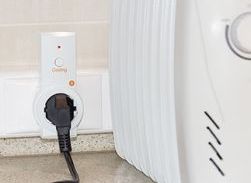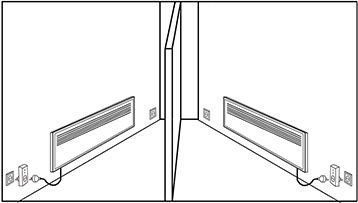Categories: Interesting electrical news, Energy saving
Number of views: 44162
Comments on the article: 20
New appliance and new principle of energy saving
 The issue of saving electricity and money to pay for it is becoming increasingly acute, especially with the introduction of social norms for electricity consumption. Therefore, citizens, homeowners and business leaders have to look for reserves to reduce electricity consumption.
The issue of saving electricity and money to pay for it is becoming increasingly acute, especially with the introduction of social norms for electricity consumption. Therefore, citizens, homeowners and business leaders have to look for reserves to reduce electricity consumption.
However, it is impossible to completely abandon the use of energy-intensive electrical appliances - the traffic of which creates the bulk of the electricity bill. Therefore, you have to compromise in order to spend less energy (money) and maintain an acceptable level of comfort. However, one cannot deceive physics, and they have not yet learned how to get the energy of their air. And, therefore, the law of conservation of energy must be strictly observed. This means that if energy has increased in one place, then in some other place it has decreased by the same value.
More recently, we talked about a new energy-saving device, network load optimizer OEL-820. In fact, this is a new kind of priority relay, working in an unusual way.
In contrast to the advertised "miracle devices to save energy" (such as SberBox, smartBox, Energy Saver, Pover Saver and similar)that are sold online OEL-820 works on a completely different principle. It is designed to effectively reduce the power consumed by energy-consuming household electrical appliances, prevent network congestion and shut down the machine when there is not enough limit for the allowed power allocated to a house or premises.
The principle of operation of the new device is simple: the redistribution of electric power between a pair of energy-intensive consumers, depending on their priority. Automatic remote shutdown of a non-priority consumer during priority operation.
Thus, the device works on the principle of a swing: if a priority electrical device is turned on, then a non-priority one is turned off at that time. The leading and setting operating time of a non-priority electrical appliance is a priority electrical appliance.
In the examples of use, OEL-820 is usually considered in the context of solving one and the main problem - connecting additional consumers with insufficient permitted power. In this case, by reducing the total power consumption, it becomes possible to connect additional consumers without acquiring additional electric power. The issue of reducing energy costs was not put at the forefront ...
But it turned out to be in vain! The abnormal cold of late January confirmed this.
Consider the work of the OEL-820 with two electroconvectors in different rooms. At the same time, we believe that the parameters of the heating devices correspond to the parameters of the heated rooms.

When the priority electric convector A is turned on in the heating mode (in the first room), the non-priority electric convector B (in the second room) is turned off. As soon as the temperature in the first room reaches the set value, priority electric convector A will turn off the heat and finish the next work cycle. The duty cycle of non-priority appliance B.
After a while, the temperature in the second room will reach the set value and non-priority appliance B will turn off. For some time, depending on the quality of the thermal insulation of the rooms, both electric convectors will be turned off. Then, the temperature in the first room will drop to the value set on the thermostat, and priority electric convector A will start a new duty cycle.
What about energy savings?
The power consumption of a pair of electric convectors of 1 kW is only 1 kW! Accordingly, the total consumption of four electroconvectors of 1 kW each is only 2 kW instead of 4 kW! Those. there is a decrease in the total power consumption of a pair of energy-intensive electrical appliances by 2 times!
This is energy saving. But, from the point of view - “so that the allocated energy resource is enough for a larger number of consumers, without buying additional energy resources”.
In the case considered, a decrease in power consumption will not be reflected in the electricity bill, because each heating device works as long as it needs to heat its room.
But, it turned out that in practice there are often "imperfect" operating conditions for non-priority heating electrical appliances, when due to the mismatch of their capacities with the operating conditions, an excessive consumption of electricity occurs. For example, if the electric convector installed in the vestibule, garage, utility room, etc. is not priority. with insufficient thermal insulation of the room. Or the power of the convector is insufficient.
Another case is a non-priority storage water heater with a long time for heating water or when the water flow exceeds the time of its full heating. Those. energy saving (including in monetary terms) occurs in cases where the duration of the non-priority consumer’s work cycle exceeds the priority work cycle. The more it exceeds, the greater the savings.
In such cases, the OEL-820 network load optimizer is able to really save up to 50% of the electricity bill consumed by a pair of energy-intensive electrical appliances.
If there are several such pairs in the house, then the material savings of each pair will be summed up in the total savings. Moreover, the figure of maximum achievable savings with the OEL-820 is greater than that of traditional switchgear devices for disconnecting non-priority loads.
For example, Legrand, on its Russian site, claims a theoretical maximum of 40% savings in electric convection heating (by turning off non-priority heaters in non-residential premises and lowering the average temperature).
An example from life. The cafe bought a coffee machine in the bar, but when it was turned on, the machine began to turn off. We put OEL-820 on a coffee machine and a storage tank of 100 liters. Life has improved - the machine does not turn off. It turned out that the water heater is switched on for heating almost constantly, because it has a large heating time, and the kitchen’s water consumption is even greater.
Counted. It turned out that the OEL-820 load optimizer saves about 5,000 rubles a year only by turning off the water heater for the duration of the coffee machine. Those. by reducing the on time of the TEN by about 10%. This practically does not affect the water temperature: it is not boiling, but hot.
As they say, there would be no evil, goodness would not happen.
Yuri Shurchkov
See also:Example of sharing a voltage regulator with an OEL-820 load optimizer
See also at bgv.electricianexp.com
:
